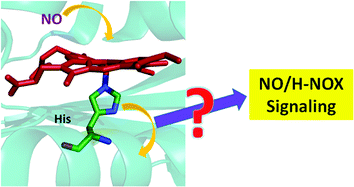Is histidine dissociation a critical component of the NO/H-NOX signaling mechanism? Insights from X-ray absorption spectroscopy†
Abstract
The H-NOX (

- This article is part of the themed collection: New Talent: Americas
* Corresponding authors
a
Department of Chemistry, Stony Brook University, Stony Brook, New York 11794-3400, USA
E-mail:
elizabeth.boon@stonybrook.edu
Fax: +1-631-632-7960
b Case Western Reserve University Center for Synchrotron Biosciences and Center for Proteomics and Bioinformatics, National Synchrotron Light Source, Brookhaven National Laboratory, Upton, New York 11973, USA
The H-NOX (

 Please wait while we load your content...
Something went wrong. Try again?
Please wait while we load your content...
Something went wrong. Try again?
Z. Dai, E. R. Farquhar, D. P. Arora and E. M. Boon, Dalton Trans., 2012, 41, 7984 DOI: 10.1039/C2DT30147D
To request permission to reproduce material from this article, please go to the Copyright Clearance Center request page.
If you are an author contributing to an RSC publication, you do not need to request permission provided correct acknowledgement is given.
If you are the author of this article, you do not need to request permission to reproduce figures and diagrams provided correct acknowledgement is given. If you want to reproduce the whole article in a third-party publication (excluding your thesis/dissertation for which permission is not required) please go to the Copyright Clearance Center request page.
Read more about how to correctly acknowledge RSC content.
 Fetching data from CrossRef.
Fetching data from CrossRef.
This may take some time to load.
Loading related content
